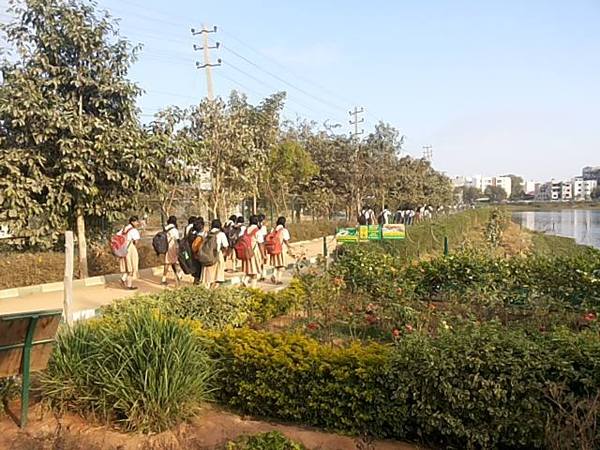Evangelical Social Action Forum (ESAF) in association with Citizens for Sustainability (CiFoS) with the support of B.PAC is organising the Walk to School on Saturday Program (WSS) to encourage children to adopt the Active and Safe Routes to School (ASRTS) initiative.

File pic. Pic: Shree D N
Six schools in Sanjay Nagar will participate in this initiative which is bring organised on December 5th 2015.
Background
Active commuting has reduced in the recent days due to many reasons. Lack of last mile connectivity and inadequate public transport have paved way for the increase in use of private vehicles. Even the buffer area of three km within the school premises is at stake at many locations. Recent research shows that children who are driven to school, do not know anything about their environment and neighbourhood. Passion towards nature is lost, inquisitive nature among children is killed, and is replaced by many gadgets in the market.
Adding to all these woes, play space crunch in every community has forced the children to be at home. This has encouraged them to follow a sedentary lifestyle either engaged with TV, internet or gadgets.
All these have increased the prevalence of obesity, diabetes, hypertension and cardio vascular diseases in children at a young age itself. The prelevance of these Non Communicable Diseases (NCD) can be reversed to an extent if we adhere to active transportation. Pollution emitting from the vehicles has marred the quality of air in the environment.
Global recommendation by WHO on physical activities for health among the 5 – 17 years age group is to have at least 60 minutes of vigorous to moderate physical activity. By adopting non motorised modes of transport to school, children can benefit, and meet their required physical activity as per the recommendation to avoid the lifestyle diseases.
Active transportation has double benefits when it helps to reduce the pollution in the neighbourhood, and contributes to the safety of the children too.
What is ASRTS?
ASRTS is a campaign to find fun, safe and convenient opportunities for children to go to school. The program encourages children residing within a one to three km radius of their school to be part of the initiative.
By being part of this initiative, children are encouraged to be physically active and adopt a healthy lifestyle. It generates wider teachings about the importance and benefits of walking and early identification of safety rules. By adapting to this active mode of transportation, social interaction among their peers and others in the community opens up. Moreover, this provides an opportunity for parents to spend quality time with their wards. As a result of this, children reach school better prepared, leading to them be more alert, with an improved attention span.
What is WSS and where is it happening?
The WSS event includes awareness programs that are already in process in the six schools that have shown interest to participate. These schools will have their students and teachers who live within one km of the school to walk, and those who live within a range of two km from the school to cycle to school or use other means of sustainable transport. Schools have also agreed to stop the school buses at a short distance away from the school gate so that the children can experience the joy of walking. Other children are welcome to join the walk from common spots that have been identified in the area. Approximately 2,000 children study in these schools, falling in the age group of 11 to 16 years; of them, we expect about 1,000 to 1,500 children to participate on December 5th.
As a part of the same program, we plan to conduct certain competitions in the schools in the locality to encourage the children to walk or use sustainable forms of transport to school. The activities include:
-
Map my route – Children will draw the route they took from their homes to school, highlighting the good things and the bad things that they noticed on the way.
-
Essay writing – Healthy Happy Neighborhood, My Sanjaynagar, My Pride
-
Poster making competition – My Sanjaynagar
The competitions shall be evaluated and the winners shall be appreciated and encouraged during the Cycle Day that will take place on Feb 7th 2016 in Sanjay Nagar
What does the future hold?
-
The mode of transport that each child travels by will be monitored by the respective schools
-
Children will be encouraged to use sustainable means of transport
-
The data collected from students and teachers will help in building better and sustainable infrastructure for the students
About ESAF
ESAF, in support with HealthBridge works on making cities livable for children across the country. Through this project, children are encouraged to be physically active and adopt safe commute while they move around. Couple of programs designed to encourage these efforts are parks program, ASRTS, and pedestrian rights program. The team is also a core organising member of BCOS (Bengaluru Coalition for Open Streets) who organise Cycle Day across Bangalore city.
About CiFos
CiFoS is a team from the Sanjaynagar area which includes an enthusiastic set of people working for the development of the neighbourhood. Since April 2015, they have been successfully conducting the Cycle Day events. Waste segregation and life skills training for children are also some of the areas they give prime importance to.
Great initiative, but I worry that there might not be a sidewalk to walk on, placing the children in danger of being run over by vehicles. And where there is a sidewalk, the children are again in danger of being run over by motorbikes.